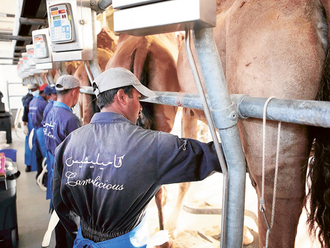
The problem with modern diets is that they rely too heavily on modern, processed foods. If only we emulated the eating habits of our Paleolithic predecessors, we’d be healthier and less obese. That’s the premise of popular “paleo” diets.
“We are Stone Agers living in the Space Age,” writes Loren Cordain in his book “The Paleo Diet: Lose Weight and Get Healthy by Eating the Foods You Were Designed to Eat.”
“Nature determined what our bodies needed thousands of years before civilisation developed, before people started farming and raising domesticated livestock,” writes Cordain, a professor emeritus at Colorado State University.
The paleo diet consists of meat from grass-fed animals, fish, fruit, vegetables, eggs, nuts, seeds and olive oil, along with plant-based oils such as walnut, flaxseed, avocado and coconut. The diet forbids grains, cereals, legumes (such as beans and peanuts), potatoes, salt, dairy products, processed foods and refined sugars.
“The idea is to try and mimic the food groups that our ancestors ate before the advent of agriculture,” Cordain says.
Why should we eat like our ancestors did during the Paleolithic period, which ended about 12,000 years ago? Because our genes have changed very little in the 300 or so generations since then, Cordain told me, and they’re adapted to a world where food was hunted, fished or gathered from the natural environment. Our bodies didn’t evolve to run on the refined foods found on grocery shelves today, he says.
But nor did we evolve to be healthy, says Daniel Lieberman, a professor of human evolutionary biology at Harvard University and author of “The Story of the Human Body: Evolution, Health, and Disease”.
What drives evolutionary adaptations isn’t health, it’s factors that affect reproductive fitness, Lieberman says. “Natural selection really only cares about one thing, and that’s reproductive success.” Evolution favours traits that allow a species to produce lots of offspring.
If the people who lived before agriculture were healthier than us, they rarely lived long enough to reap these benefits, says Kenneth Sayers, an anthropologist at the Language Research Center of Georgia State University. It was unusual for hunter-gatherers to live much beyond reproductive age, he says, and “it’s hard to be healthy when you’re dead.”
The paleo diet is built on nostalgia and erroneous notions of how evolution works, says Marlene Zuk, an evolutionary biologist at the University of Minnesota in St Paul and author of “Paleofantasy: What Evolution Really Tells Us About Sex, Diet, and How We Live”.
She says “there’s always been this thread of people wanting to live what they perceive is a more natural lifestyle from the past, whether it’s pre-Industrial Revolution or pre-agriculture or even the 1950s.”
The idea that the Paleolithic era represents some magical time in our evolutionary history has no basis in fact, she says. Evolution is a dynamic process that doesn’t build to some perfect harmony or endpoint, but instead produces a mishmash of trade-offs and compromises. As an example of this, she points to bipedalism, which made humans more mobile but also makes us prone to back pain and difficulties giving birth. “It’s not like bipedal humans should have said, ‘Wait, wait! Stay in the trees!’” she says.
Another problem with the paleo diet is that it makes unscientific assumptions about what our ancestors ate, Lieberman says. “There was no one single paleo diet; there were many,” he says. Our Stone Age relatives lived in a diverse range of habitats, from tropical regions of Africa to rain forests, boreal forests and tundra regions, he says, and their diets varied according to what was available in these habitats. “There is no one time and place and habitat to which we’re adapted,” Lieberman says.
Hominids (humans and our immediate ancestors from the genuses Ardipithecus, Australopithecus and Homo) are omnivores capable of living in a wide range of habitats, eating a wide variety of foods, says Sayers, who recently co-authored an article in the Quarterly Review of Biology examining the ecology and diets of human ancestors.
Few health professionals would quibble with paleo diet recommendations that involve increased physical activity or the avoidance of highly processed foods, Sayers says. But to set recommendations about what a modern diet should consist of based on an estimation of what Paleolithic humans ate overlooks the wide variety of foods that these ancestors consumed. “We are ‘generalists’ in the strongest sense of the word,” he says.
Some of the advice offered by the paleo diets makes sense, Lieberman says, even if the stories to explain it don’t. Few would dispute, for instance, that modern diets often contain too much sugar and empty calories. But other pieces of paleo diet advice contradict what we know about human evolution, he says. For instance, paleo diets forbid dairy products, but numerous people around the globe have inherited a genetic mutation that enables them to metabolise milk as adults. This trait evolved independently at least seven times, Lieberman says, so it’s simply wrong to say that humans haven’t evolved to eat dairy foods.
Nor is it correct to assert that our Paleolithic ancestors’ diets were devoid of grain.
“We know that hunter-gatherers in the Middle East were eating grains,” Lieberman says, because archaeologists have found remains of wild barley they were gathering, along with the mortars and pestles they used to grind this grain into flour. Not every population ate grains, Lieberman says, but those who had them available certainly did. “Whether they were healthy was beside the point,” he says.
Cordain points to studies — such as one from 2009, that found that a paleo diet improved glycemic control and several cardiovascular risk factors among 13 diabetic patients — as evidence that his paleo diet can improve health. But whether the diet is superior to other ways of eating remains a point of debate.
Jessica Larson, a nutritionist and registered dietitian at the Center for Nutrition Policy and Promotion at the USDA, cautions, “At this time, there is not enough research on the paleo diet and its potential impact on health over time.”
–Washington Post












